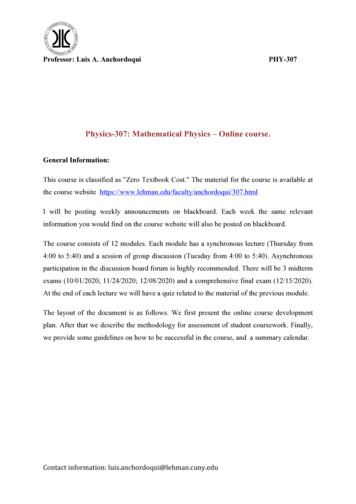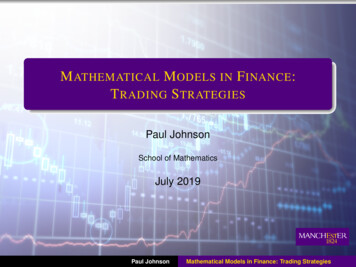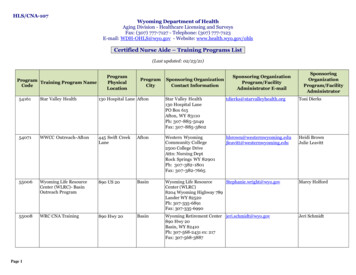
Transcription
Professor: Luis A. AnchordoquiPHY-307Physics-307: Mathematical Physics – Online course.General Information:This course is classified as "Zero Textbook Cost." The material for the course is available atthe course website lI will be posting weekly announcements on blackboard. Each week the same relevantinformation you would find on the course website will also be posted on blackboard.The course consists of 12 modules. Each module has a synchronous lecture (Thursday from4:00 to 5:40) and a session of group discussion (Tuesday from 4:00 to 5:40). Asynchronousparticipation in the discussion board forum is highly recommended. There will be 3 midtermexams (10/01/2020; 11/24/2020; 12/08/2020) and a comprehensive final exam (12/15/2020).At the end of each lecture we will have a quiz related to the material of the previous module.The layout of the document is as follows. We first present the online course developmentplan. After that we describe the methodology for assessment of student coursework. Finally,we provide some guidelines on how to be successful in the course, and a summary n.cuny.edu
Professor: Luis A. AnchordoquiPHY-307Course Development PlanModule 1 (Online)Date: 08/27/2020 (Lecture) & 09/01/2020 (Group discussion)Topic: Analytic FunctionsDescription: Complex Analysis I: Complex Algebra. Functions of a Complex Variable.Learning Objectives:1.The educational methodology of this subject proposes to integrate the domain ofconcepts and knowledge from mathematics into practical application of physicsphenomena, and the development of abilities and skills to solve example problems.2. Student discussion in interactive forums, which aim to improve the instrumentalaspects learned through the lectures and experiences outside the walls.Your Content: Reading Materials:L. A. Anchordoqui and T. C. Paul, Mathematical Models of Physics Problems (NovaPublishers, 2013); Chapter 1 Complementary material:G. B. Arfken, H. J. Weber, and F. E. Harris Mathematical Methods for Physicists’’(7th Edition) (Academic Press, 2012)Assignments, Activities: Attend a live synchronous lecture and interact with meSlide lecture available @ https://www.lehman.edu/faculty/anchordoqui/307 1.pdf Solve physics problems.Downloadable @ http://lehman.edu/faculty/anchordoqui/307-P1.pdf Group discussion of problem solutions. Written summary of all .cuny.edu
Professor: Luis A. AnchordoquiPHY-307 In relation to a problem assigned for a discussion session: create a short videosummarizing the problem and solution, questions from other students, and myfeedback.Reflective Questions: How are students connecting with you this week?o Q&A forum and email How are students connecting with each other this week?o Q&A forumo Discussion board forum (Module 1) How are students showing what they are learning this week?o Presentation of assessment problems in discussion sessiono Summary in a video using an.cuny.edu
Professor: Luis A. AnchordoquiPHY-307Module 2 (Online)Date: 09/03/2020 (Lecture) & 09/08/2020 (Group discussion)Topic: Integration in the Complex emanditsApplications.Learning Objectives:1.The educational methodology of this subject proposes to integrate the domain ofconcepts and knowledge from mathematics into practical application of physicsphenomena, and the development of abilities and skills to solve example problems.2. Student discussion in interactive forums, which aim to improve the instrumentalaspects learned through the lectures and experiences outside the walls.Your Content: Reading Materials:L. A. Anchordoqui and T. C. Paul, Mathematical Models of Physics Problems (NovaPublishers, 2013) Chapter 1 Complementary material:G. B. Arfken, H. J. Weber, and F. E. Harris Mathematical Methods for Physicists’’(7th Edition) (Academic Press, 2012)Assignments, Activities: Attend a live synchronous lecture and interact with meSlide lecture available @ https://www.lehman.edu/faculty/anchordoqui/307 2.pdf Solve physics problemsDownloadable @ http://lehman.edu/faculty/anchordoqui/307-P2.pdf Group discussion of problem solutions. Written summary of all problems In relation to a problem assigned for a discussion session: create a short videosummarizing the problem and solution, questions from other students, and man.cuny.edu
Professor: Luis A. AnchordoquiPHY-307 Watch an asynchronous video summary made by me of each lecture prior to attendingthe next week's lecture.Reflective Questions: How are students connecting with you this week?o Q&A forum and email How are students connecting with each other this week?o Q&A forumo Discussion board forum (Module 2) How are students showing what they are learning this week?o Presentation of assessment problems in discussion sessiono Summary in a video using an.cuny.edu
Professor: Luis A. AnchordoquiPHY-307Module 3 (Online)Date: 09/10/2020 (Lecture) & 09/15/2020 – 09/22/2020 (Group discussion)Topic: Isolated Singularities and Residues.Description: ComplexAnalysisIII: Isolated Singularities and Residues. Laurent’s theorem.Cuachy’s residue theorem. Jordan’s lemma. Cauchy principal value.Learning Objectives:1.The educational methodology of this subject proposes to integrate the domain ofconcepts and knowledge from mathematics into practical application of physicsphenomena, and the development of abilities and skills to solve example problems.2. Student discussion in interactive forums, which aim to improve the instrumentalaspects learned through the lectures and experiences outside the walls.Your Content: Reading Materials:L. A. Anchordoqui and T. C. Paul, Mathematical Models of Physics Problems (NovaPublishers, 2013) Chapter 1 Complementary material:G. B. Arfken, H. J. Weber, and F. E. Harris Mathematical Methods for Physicists’’(7th Edition) (Academic Press, 2012)Assignments, Activities: Attend a live synchronous lecture and interact with meSlide lecture available @ https://www.lehman.edu/faculty/anchordoqui/307 3.pdf Solve physics problems.Downloadable @ http://lehman.edu/faculty/anchordoqui/307-P3.pdf Group discussion of problem solutions. Written summary of all problems In relation to a problem assigned for a discussion session: create a short videosummarizing the problem and solution, questions from other students, and man.cuny.edu
Professor: Luis A. AnchordoquiPHY-307 Watch an asynchronous video summary made by me of each lecture prior to attendingthe next week's lecture.Reflective Questions: How are students connecting with you this week?o Q&A forum and email How are students connecting with each other this week?o Q&A forumo Discussion board forum (Module 3) How are students showing what they are learning this week?o Presentation of assessment problems in discussion sessiono Summary in a video using an.cuny.edu
Professor: Luis A. AnchordoquiPHY-307Module 4 (Online)Date: 09/17/2020 (Lecture) & 10/06/2020 (Group discussion)Topic: Elements of Linear AlgebraDescription: Linear spaces. Matrices and linear transformationsLearning Objectives:1.The educational methodology of this subject proposes to integrate the domain ofconcepts and knowledge from mathematics into practical application of physicsphenomena, and the development of abilities and skills to solve example problems.2. Student discussion in interactive forums, which aim to improve the instrumentalaspects learned through the lectures and experiences outside the walls.Your Content: Reading Materials:L. A. Anchordoqui and T. C. Paul, Mathematical Models of Physics Problems (NovaPublishers, 2013) Chapter 2 Complementary material:G. F. D. Duff and D. Naylor, Differential Equations of Applied Mathematics (JohnWiley & Sons, 1966)G. B. Arfken, H. J. Weber, and F. E. Harris Mathematical Methods for Physicists’’(7th Edition) (Academic Press, 2012)Assignments, Activities: Attend a live synchronous lecture and interact with meSlide lecture available @ https://www.lehman.edu/faculty/anchordoqui/307 4.pdf Solve physics problems.Downloadable @ http://lehman.edu/faculty/anchordoqui/307-P4.pdf Group discussion of problem solutions. Written summary of all .cuny.edu
Professor: Luis A. AnchordoquiPHY-307 In relation to a problem assigned for a discussion session: create a short videosummarizing the problem and solution, questions from other students, and myfeedback. Watch an asynchronous video summary made by me of each lecture prior to attendingthe next week's lecture.Reflective Questions: How are students connecting with you this week?o Q&A forum and email How are students connecting with each other this week?o Q&A forumo Discussion board forum (Module 4) How are students showing what they are learning this week?o Presentation of assessment problems in discussion sessiono Summary in a video using an.cuny.edu
Professor: Luis A. AnchordoquiPHY-307Module 5 (Online)Date: 09/24/2020 (Lecture) & 10/13/2020 (Group discussion)Topic: Initial Value Problem (Picard’s Theorem)Description: Ordinary differential equations I: Setting the Stage. Initial Value Problem:Picard’s existence and uniqueness theoremLearning Objectives:1.The educational methodology of this subject proposes to integrate the domain ofconcepts and knowledge from mathematics into practical application of physicsphenomena, and the development of abilities and skills to solve example problems.2. Student discussion in interactive forums, which aim to improve the instrumentalaspects learned through the lectures and experiences outside the walls.Your Content: Reading Materials:L. A. Anchordoqui and T. C. Paul, Mathematical Models of Physics Problems (NovaPublishers, 2013) Chapter 3 Complementary material:G. F. D. Duff and D. Naylor, Differential Equations of Applied Mathematics (JohnWiley & Sons, 1966)G. B. Arfken, H. J. Weber, and F. E. Harris Mathematical Methods for Physicists’’(7th Edition) (Academic Press, 2012)Assignments, Activities: Attend a live synchronous lecture and interact with meSlide lecture available @ https://www.lehman.edu/faculty/anchordoqui/307 5.pdf Solve physics problems.Downloadable @ http://lehman.edu/faculty/anchordoqui/307-P5.pdf Group discussion of problem solutions. Written summary of all .cuny.edu
Professor: Luis A. AnchordoquiPHY-307 In relation to a problem assigned for a discussion session: create a short videosummarizing the problem and solution, questions from other students, and myfeedback. Watch an asynchronous video summary made by me of each lecture prior to attendingthe next week's lecture.Reflective Questions: How are students connecting with you this week?o Q&A forum and email How are students connecting with each other this week?o Q&A forumo Discussion board forum (Module 5) How are students showing what they are learning this week?o Presentation of assessment problems in discussion sessiono Summary in a video using an.cuny.edu
Professor: Luis A. AnchordoquiPHY-307Module 6 (Online)Date: 10/ 08/2020 (Lecture) & 10/20/2020 (Group discussion)Topic: Initial Value Problem (Green Matrix)Description: Ordinary differential equations II: Initial Value Problem: Systems of first-orderlinear differential equations Green matrix as a generalized function.Learning Objectives:1.The educational methodology of this subject proposes to integrate the domain ofconcepts and knowledge from mathematics into practical application of physicsphenomena, and the development of abilities and skills to solve example problems.2. Student discussion in interactive forums, which aim to improve the instrumentalaspects learned through the lectures and experiences outside the walls.Your Content: Reading Materials:L. A. Anchordoqui and T. C. Paul, Mathematical Models of Physics Problems (NovaPublishers, 2013) Chapter 3 Complementary material:G. F. D. Duff and D. Naylor, Differential Equations of Applied Mathematics (JohnWiley & Sons, 1966)G. B. Arfken, H. J. Weber, and F. E. Harris Mathematical Methods for Physicists’’(7th Edition) (Academic Press, 2012)Assignments, Activities: Attend a live synchronous lecture and interact with meSlide lecture available @ https://www.lehman.edu/faculty/anchordoqui/307 6.pdf Solve physics problemsDownloadable @ http://lehman.edu/faculty/anchordoqui/307-P6.pdf Group discussion of problem solutions. Written summary of all .cuny.edu
Professor: Luis A. AnchordoquiPHY-307 In relation to a problem assigned for a discussion session: create a short videosummarizing the problem and solution, questions from other students, and myfeedback. Watch an asynchronous video summary made by me of each lecture prior to attendingthe next week's lecture.Reflective Questions: How are students connecting with you this week?o Q&A forum and email How are students connecting with each other this week?o Q&A forumo Discussion board forum (Module 6) How are students showing what they are learning this week?o Presentation of assessment problems in discussion sessiono Summary in a video using an.cuny.edu
Professor: Luis A. AnchordoquiPHY-307Module 7 (Online)Date: 10/15 /2020 (Lecture) & 10/27/2020 (Group discussion)Topic: Boundary Value Problem (Sturm-Liouville Operator)Description: Ordinary differential equations III: Boundary value problem. Self-adjointnessof Sturm-Liouville operator Green function of Sturm-Liouville operator.Learning Objectives:1.The educational methodology of this subject proposes to integrate the domain ofconcepts and knowledge from mathematics into practical application of physicsphenomena, and the development of abilities and skills to solve example problems.2. Student discussion in interactive forums, which aim to improve the instrumentalaspects learned through the lectures and experiences outside the walls.Your Content: Reading Materials:L. A. Anchordoqui and T. C. Paul, Mathematical Models of Physics Problems (NovaPublishers, 2013) Chapter 3 Complementary material:G. F. D. Duff and D. Naylor, Differential Equations of Applied Mathematics (JohnWiley & Sons, 1966)G. B. Arfken, H. J. Weber, and F. E. Harris Mathematical Methods for Physicists’’(7th Edition) (Academic Press, 2012)Assignments, Activities: Attend a live synchronous lecture and interact with meSlide lecture available @ https://www.lehman.edu/faculty/anchordoqui/307 7.pdf Solve physics problemsDownloadable @ http://lehman.edu/faculty/anchordoqui/307-P7.pdf Group discussion of problem solutions. Written summary of all .cuny.edu
Professor: Luis A. AnchordoquiPHY-307 In relation to a problem assigned for a discussion session: create a short videosummarizing the problem and solution, questions from other students, and myfeedback. Watch an asynchronous video summary made by me of each lecture prior to attendingthe next week's lecture.Reflective Questions: How are students connecting with you this week?o Q&A forum and email How are students connecting with each other this week?o Q&A forumo Discussion board forum (Module 7) How are students showing what they are learning this week?o Presentation of assessment problems in discussion sessiono Summary in a video using an.cuny.edu
Professor: Luis A. AnchordoquiPHY-307Module 8 (Online)Date: 10/22/2020 (Lecture) & 11/03/2020 (Group discussion)Topic: Boundary Value Problem (Special Functions)Description: Ordinary differential equations IV: Boundary value problem. Series solutions tohomogeneous linear equations.Learning Objectives:1.The educational methodology of this subject proposes to integrate the domain ofconcepts and knowledge from mathematics into practical application of physicsphenomena, and the development of abilities and skills to solve example problems.2. Student discussion in interactive forums, which aim to improve the instrumentalaspects learned through the lectures and experiences outside the walls.Your Content: Reading Materials:L. A. Anchordoqui and T. C. Paul, Mathematical Models of Physics Problems (NovaPublishers, 2013) Chapter 3 Complementary material:G. F. D. Duff and D. Naylor, Differential Equations of Applied Mathematics (JohnWiley & Sons, 1966)G. B. Arfken, H. J. Weber, and F. E. Harris Mathematical Methods for Physicists’’(7th Edition) (Academic Press, 2012)Assignments, Activities: Attend a live synchronous lecture and interact with meSlide lecture available @ https://www.lehman.edu/faculty/anchordoqui/307 8.pdf Solve physics problems.Downloadable @ http://lehman.edu/faculty/anchordoqui/307-P8.pdf Group discussion of problem solutions. Written summary of all .cuny.edu
Professor: Luis A. AnchordoquiPHY-307 In relation to a problem assigned for a discussion session: create a short videosummarizing the problem and solution, questions from other students, and myfeedback. Watch an asynchronous video summary made by me of each lecture prior to attendingthe next week's lecture.Reflective Questions: How are students connecting with you this week?o Q&A forum and email How are students connecting with each other this week?o Q&A forumo Discussion board forum (Module 8) How are students showing what they are learning this week?o Presentation of assessment problems in discussion sessiono Summary in a video using an.cuny.edu
Professor: Luis A. AnchordoquiPHY-307Module 9 (Online)Date: 10/29/2020 (Lecture) & 11/10/2020 (Group discussion)Topic: Fourier Series and Fourier TransformDescription: Ordinary differential equations V: Fourier analysis. Fourier Series. FourierTransformLearning Objectives:1.The educational methodology of this subject proposes to integrate the domain ofconcepts and knowledge from mathematics into practical application of physicsphenomena, and the development of abilities and skills to solve example problems.2. Student discussion in interactive forums, which aim to improve the instrumentalaspects learned through the lectures and experiences outside the walls.Your Content: Reading Materials:L. A. Anchordoqui and T. C. Paul, Mathematical Models of Physics Problems (NovaPublishers, 2013) Chapter 3 Complementary material:G. F. D. Duff and D. Naylor, Differential Equations of Applied Mathematics (JohnWiley & Sons, 1966)G. B. Arfken, H. J. Weber, and F. E. Harris Mathematical Methods for Physicists’’(7th Edition) (Academic Press, 2012)Assignments, Activities: Attend a live synchronous lecture and interact with meSlide lecture available @ https://www.lehman.edu/faculty/anchordoqui/307 9.pdf Solve physics problems.Downloadable @ http://lehman.edu/faculty/anchordoqui/307-P9.pdf Group discussion of problem solutions. Written summary of all .cuny.edu
Professor: Luis A. AnchordoquiPHY-307 In relation to a problem assigned for a discussion session: create a short videosummarizing the problem and solution, questions from other students, and myfeedback. Watch an asynchronous video summary made by me of each lecture prior to attendingthe next week's lecture.Reflective Questions: How are students connecting with you this week?o Q&A forum and email How are students connecting with each other this week?o Q&A forumo Discussion board forum (Module 9) How are students showing what they are learning this week?o Presentation of assessment problems in discussion sessiono Summary in a video using an.cuny.edu
Professor: Luis A. AnchordoquiPHY-307Module 10 (Online)Date: 11/05/2020 (Lecture) & 11/17/2020 (Group discussion)Topic: Hyperbolic Partial Differential Equation (Wave equation)Description: Partial Differential Equations I: Taxonomy. Wave Equation.Learning Objectives:1.The educational methodology of this subject proposes to integrate the domain ofconcepts and knowledge from mathematics into practical application of physicsphenomena, and the development of abilities and skills to solve example problems.2. Student discussion in interactive forums, which aim to improve the instrumentalaspects learned through the lectures and experiences outside the walls.Your Content: Reading Materials:L. A. Anchordoqui and T. C. Paul, Mathematical Models of Physics Problems (NovaPublishers, 2013) Chapter 4 Complementary material:G. F. D. Duff and D. Naylor, Differential Equations of Applied Mathematics (JohnWiley & Sons, 1966)G. B. Arfken, H. J. Weber, and F. E. Harris Mathematical Methods for Physicists’’(7th Edition) (Academic Press, 2012)Assignments, Activities: Attend a live synchronous lecture and interact with meSlide lecture available @ https://www.lehman.edu/faculty/anchordoqui/307 10.pdf Solve physics problems.Downloadable @ http://lehman.edu/faculty/anchordoqui/307-P10.pdf Group discussion of problem solutions. Written summary of all .cuny.edu
Professor: Luis A. AnchordoquiPHY-307 In relation to a problem assigned for a discussion session: create a short videosummarizing the problem and solution, questions from other students, and myfeedback. Watch an asynchronous video summary made by me of each lecture prior to attendingthe next week's lecture.Reflective Questions: How are students connecting with you this week?o Q&A forum and email How are students connecting with each other this week?o Q&A forumo Discussion board forum (Module 10) How are students showing what they are learning this week?o Presentation of assessment problems in discussion sessiono Summary in a video using an.cuny.edu
Professor: Luis A. AnchordoquiPHY-307Module 11 (Online)Date: 11/ 12/2020 (Lecture) & 12/01/2020 (Group discussion)Topic: Parabolic Partial Differential Equation (Diffusion equation)Description: Partial Differential Equations II: Diffusion Equation. Heat flow. Diffusion in aninfinitely long metal bar. Diffusion in a finite metal bar.Learning Objectives:1.The educational methodology of this subject proposes to integrate the domain ofconcepts and knowledge from mathematics into practical application of physicsphenomena, and the development of abilities and skills to solve example problems.2. Student discussion in interactive forums, which aim to improve the instrumentalaspects learned through the lectures and experiences outside the walls.Your Content: Reading Materials:L. A. Anchordoqui and T. C. Paul, Mathematical Models of Physics Problems (NovaPublishers, 2013) Chapter 4 Complementary material:G. F. D. Duff and D. Naylor, Differential Equations of Applied Mathematics (JohnWiley & Sons, 1966)G. B. Arfken, H. J. Weber, and F. E. Harris Mathematical Methods for Physicists’’(7th Edition) (Academic Press, 2012)Assignments, Activities: Attend a live synchronous lecture and interact with meSlide lecture available @ https://www.lehman.edu/faculty/anchordoqui/307 11.pdf Solve physics problems.Downloadable @ http://lehman.edu/faculty/anchordoqui/307-P11.pdf Group discussion of problem solutions. Written summary of all .cuny.edu
Professor: Luis A. AnchordoquiPHY-307 In relation to a problem assigned for a discussion session: create a short videosummarizing the problem and solution, questions from other students, and myfeedback. Watch an asynchronous video summary made by me of each lecture prior to attendingthe next week's lecture.Reflective Questions: How are students connecting with you this week?o Q&A forum and email How are students connecting with each other this week?o Q&A forumo Discussion board forum (Module 11) How are students showing what they are learning this week?o Presentation of assessment problems in discussion sessiono Summary in a video using an.cuny.edu
Professor: Luis A. AnchordoquiPHY-307Module 12 (Online)Date: 11/ 19 /2020 (Lecture) & 12 /03/2020 (Group discussion)Topic: Elliptic Partial Differential Equation (Laplace equation)Description: Partial Differential Equations III: Laplace Equation. Harmonics functions.Spherical harmonics. Green function for Laplace operator.Learning Objectives:1.The educational methodology of this subject proposes to integrate the domain ofconcepts and knowledge from mathematics into practical application of physicsphenomena, and the development of abilities and skills to solve example problems.2. Student discussion in interactive forums, which aim to improve the instrumentalaspects learned through the lectures and experiences outside the walls.Your Content: Reading Materials:L. A. Anchordoqui and T. C. Paul, Mathematical Models of Physics Problems (NovaPublishers, 2013) Chapter 4 Complementary material:G. F. D. Duff and D. Naylor, Differential Equations of Applied Mathematics (JohnWiley & Sons, 1966)G. B. Arfken, H. J. Weber, and F. E. Harris Mathematical Methods for Physicists’’(7th Edition) (Academic Press, 2012)Assignments, Activities: Attend a live synchronous lecture and interact with meSlide lecture available @ https://www.lehman.edu/faculty/anchordoqui/307 12.pdf Solve physics problemsDownloadable @ http://lehman.edu/faculty/anchordoqui/307-P12.pdf Group discussion of problem solutions. Written summary of all .cuny.edu
Professor: Luis A. AnchordoquiPHY-307 In relation to a problem assigned for a discussion session: create a short videosummarizing the problem and solution, questions from other students, and myfeedback. Watch an asynchronous video summary made by me of each lecture prior to attendingthe next week's lecture.Reflective Questions: How are students connecting with you this week?o Q&A forum and email How are students connecting with each other this week?o Q&A forumo Discussion board forum (Module 12) How are students showing what they are learning this week?o Presentation of assessment problems in discussion sessiono Summary in a video using an.cuny.edu
Professor: Luis A. AnchordoquiPHY-307Assessment of student courseworkThe weekly activities of the courses are divided into lectures and recitations. The recitationsare synchronous student presentations of assigned problems. In short, the student presentingthe problem is the lead, and I play the role of the moderator between the lead and theclass. Homework sets for group discussions are available on the course website. Eachhomework set consists of questions used as worked examples in lecture, questions coveredduring discussion, and questions assigned as homework exercises. The problem assignmentswill be done at the end of each lecture. Students will not be evaluated during thepresentations to facilitate a smooth discussion between the class. Each student presenting aproblem will post the solution on the Discussion Board Forum to open the debate about thatparticular problem. For selected problems, the students will create a short video summarizingthe problem and solution, questions from other students, and my feedback. The students willbe evaluated for the written solution, forum participation and the video clip. Three tests willbe given during the semester (October 1, November 24, December 8). Each test will consistof 4 problems that you will have to solve in written format, send via photo attachment, andexplain how you solved these problems in a short video clip.There will be a comprehensive final exam; Thursday December 15 at 3:45 - 5:45 PM. Thefinal will consist of 5 problems that you will also have to solve in written format, send viaphoto attachment, and explain how you solved these problems in a short video clip. The finalis mandatory and you are responsible for making sure that you can attend at this ny.edu
Professor: Luis A. AnchordoquiPHY-307 Grading policy.The overall course grade will be determined as follows:o 10 % - homework assignments (blackboard presentations)o 20% - quizzeso 45% - midterm exams (15% each)o 25% - comprehensive final examLetter grades will be assigned according to the guidelines A 90 - 100 B 80 - 90 C 65 - 80 D 50 - 65 F below 50The cutoffs for ’s and -‘s will be decided at the end of the semester.Students will have a portfolio including all their work from the semester. By the end of thesemester they will select from this portfolio what they think is the best solved problem withaccompanying video. This will help to decide the cutoffs for ’s and uny.edu
Professor: Luis A. AnchordoquiPHY-307How to be successful in Physics 307 - PLEASE READ CAREFULLY –1. This is not an asynchronous course; attendance at lectures and discussions is highlyencouraged.2. Make sure you visit the course website regularly. Check the announcements. You willhave to download a set of problems every week. Two or three problems from eachhomework set will be selected at random for quizzes.3. QUIZZES: a short (about 10-15 minutes) quiz based on the material covered in recentlectures will be given at the end of every lecture.4. TESTS: test problems are loosely based on those you will find in the homework sets.Please note that this does not
L. A. Anchordoqui and T. C. Paul, Mathematical Models of Physics Problems (Nova Publishers, 2013) Chapter 1 Complementary material: G. B. Arfken, H. J. Weber, and F. E. Harris Mathematical Methods for Physicists’’ (7th Edition) (Academic Press, 2012) Assignments, Activitie










